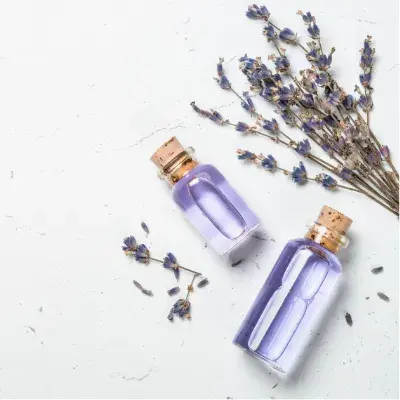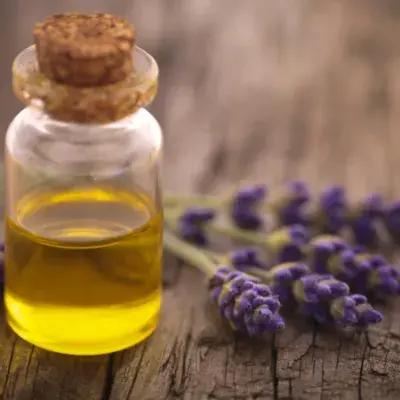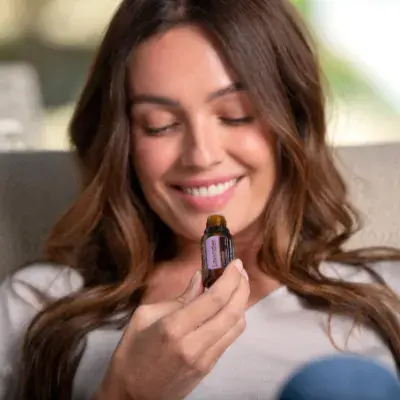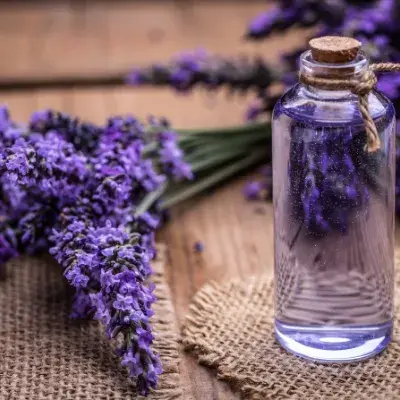In a study published in 2016, scientists found that lavender oil has a compound like geraniol, linalool, and acetate that improves hair thickness and stimulates cell growth. It also reduces hair loss and the aroma reduces stress.
For hundreds of years, people have used lavender oil to help their hair grow faster and stay healthy. Applying lavender oil to your hair can benefit you in a variety of ways, but if done incorrectly, it might cause more harm than good.
We reviewed a lot of research papers and spoke with dermatologists and hair care professionals to figure out the best technique to apply lavender oil to your hair.
In the next parts, we’ll go into the technique and the research that went into it in further detail.
Table of Contents
What does Science say of Lavender Oil’s Benefits on Hair?

A 2014 study discovered that lavender has antibacterial effects as well. This means that it aids in the prevention of the growth of germs and fungi.
Hair and scalp troubles may be prevented by applying them to the area. Additionally, it may help alleviate dandruff or itchy scalp.
In the last few years, the lavender essential oil has gotten a lot of attention for its ability to promote hair growth. Lavender oil was proven to stimulate hair growth in mice in a study conducted in 2016. In addition, their hair grew denser and thicker than usual. Hair follicle density and depth both rose dramatically after applying lavender oil, demonstrating that this oil has a noticeable effect on hair growth.
These studies suggest that lavender oil may be useful in treating hair loss due to patterns or alopecia.
The lavender essential oil was proven to be effective in preventing head lice in a 2011 study. Even head lice may be wiped out by using this product.
The anti-inflammatory and anti-dandruff properties of lavender essential oil make it an excellent choice for use on irritated or dry scalps.
When lavender oil was applied to skin inflammations and ulcers in 2012, it was shown to be extremely effective. It speeds up the healing process by reducing inflammation.
Hair growth may benefit from the use of lavender oil. Alopecia areata, a common autoimmune condition that causes hair loss, was successfully treated with a blend of thyme, rosemary, lavender, and cedarwood essential oils in a 1998 study.
How to Apply Lavender Oil to Hair in 6 Steps: As per Science
Because lavender oil is so concentrated, even little doses can be effective. Essential oils must be mixed with a carrier oil such as olive, jojoba, or grapeseed oil.
According to experts, applying lavender oil to the hair’s surface would do no good and will simply make the scalp oily. If you want to get the most out of your hair, you need to know how to oil it properly.
We’ll go over the technique and the research that went into it in greater detail in the parts that follow.
Step 1: Prepare your Hair
With a wide-toothed comb, we’ll detangle and remove any knots from the hair. The usage of lavender oil reduces the likelihood of hair breakage. This also ensures that the oil is applied and disseminated evenly throughout the scalp and hair.
Straighten each part from roots to ends to straighten your hair from top to bottom.
Step 2: Prepare the Lavender Oil

Because of the way lavender oil is manufactured, the molecules are significantly bigger than hair follicles on the scalp. As a result, at room temperature, lavender oil is unable to reach the hair follicle and have the intended effect.
The problem is solved by warming lavender oil, which breaks up the oil molecules and makes it simpler for the oil to penetrate the scalp and hair. Heated lavender oil has more therapeutic properties. For dyed or damaged hair, this is ideal. Heat seals the hair’s cuticle, allowing it to retain moisture.
7 drops essential oils + 3–4 tablespoons carrier oil
Note: Lavender Essential oils must be diluted due to their high concentration.
In a microwave-safe dish, heat the oil mixture (a glass bowl is recommended). Apply a patch test to your hand to verify that the lavender oil is not excessively hot and that you will not experience an allergic reaction.
Step 3: Apply the Lavender Oil
First, we’ll apply lavender oil to the scalp, then the crown, and finally the rest of the hair. To encourage hair development, massage your scalp with your fingertips using a circular motion. Before putting oil on your hair, give your scalp a thorough massage with your fingertips.
Utilizing lavender oil cautiously is advised. An excess of oil necessitates more frequent hair washing, which diminishes the benefits of oiling. Over-shampooing drains hair of its natural oils and nutrients, leaving it brittle, lifeless, and lacking in luster.
Step 4: Get Rid of Knots
Again, the wide-toothed comb will be used to detangle any knots that may have formed during the application of oil. This can help the lavender oil reach neglected parts of the head and reduce the likelihood of hair breakage while washing.
Be cautious when combing your hair following a massage, as the massage has loosened the cortex and roots of your hair, making them more susceptible to damage.
Step 5: Cover your Head
For the following 15 to 20 minutes, we must wear a shower cap or a cotton T-shirt over our heads. This will give you a warming sensation while simultaneously opening the pores on your scalp and cuticles. If you do this, lavender oil will permeate your scalp and hair follicles more effectively than if you don’t.
Note: Because towels are rough, you should not wrap them around your head, as the friction could cause hair damage.
Step 6: Wash Off the Lavender Oil
The process of oiling is concluded with a light shampoo and lukewarm water rinse. Wash your hair with lukewarm water to open pores and remove excess oil and debris.
Now we must wash our hair with cold water to shut the newly opened pores and keep moisture.
Lavender essential oil is highly concentrated and powerful. As a result, lavender oil (without mixing with other carrier oil) should not be applied directly to the hair or scalp. To know more, check this detailed article on How Long Should Lavender Oil be Kept in Hair?
How to Choose the Best Carrier Oil for Lavender Oil?

There are so many carrier oils on the market that it may be hard to decide which one to use. If you want the best results, choose a carrier oil that is 100% pure. Using pure carrier oil protects the chemical makeup of lavender oil and makes sure that it can be dissolved in water. If not, the carrier oil could stop the lavender oil from having the effects or benefits you want.
Don’t use carrier oils like petroleum jelly, vegetable oils, or butter because they don’t get deep enough into the scalp and hair to absorb the active ingredient.
To make it easier for you to choose a carrier oil, we’ve made a long list and put it into different groups based on your needs.
| Damaged Hair | Dry Hair | Oily Hair |
|---|---|---|
| Sweet Almond Oil | Pumpkin Seed Oil | Grapeseed Oil |
| Avocado Oil | Evening Primrose Oil | Apricot Kernel Oil |
| Coconut Oil | Castor Oil | Jojoba Oil |
| Pumpkin Seed Oil | Moringa Oil | Argan Oil |
Pro Tip
People who are allergic to nuts shouldn’t use oils made from tree nuts because they may cause an allergic reaction. In this group are oils that come from apricot kernels, argan, and almonds.
How to Dilute Lavender Oil for Hair and Scalp?
You only need a few drops of oil made from lavender. Don’t put lavender oil straight on your scalp because it could irritate the skin or cause an allergic reaction. Follow the directions on the label about how much carrier oil to add to the oil.
If you are allergic to plants, try a small amount of the oil on your scalp or skin to see if it makes you sick.
Dilution Proportions:
- For 10% dilution, you need to mix 5 teaspoons of carrier oil with 50 drops of lavender oil.
- For 5% dilution, you need to mix 5 teaspoons of carrier oil with 25 drops of lavender oil.
- For 3% dilution, you need to mix 5 teaspoons of carrier oil with 15 drops of lavender oil.
- For 2.5% dilution, you need to mix 5 teaspoons of carrier oil with 4 drops of lavender oil.
How to Choose the Best Lavender Oil?
All of the discussed studies and research indicate that lavender oil may be useful for hair health. However, if the lavender oil is of poor quality, none of these benefits will be obtained. When searching for the best lavender oil for hair, consider the following:
- Ensure that the lavender oil is formulated for cosmetic usage. Frequently, it is printed on the back of the container.
- Ensure that the lavender oil bottle is always dark and made of glass. By suppressing light, the dark hue of the bottle prevents the lavender oil from deteriorating.
- Lavender oil must always be 100 percent pure, unprocessed organic oil. Labeled as “virgin” is lavender oil that has not been refined.
- Whenever feasible, use a well-known brand.
How to Use Lavender Oil to Promote Hair Growth, Increase Density, and Prevent Hair Loss

In recent years, the lavender essential oil has gained popularity as a stimulant for hair growth. In a 2016 study, the administration of lavender oil resulted in improved hair growth. In addition, their hair grew more quickly and densely than usual. The density and depth of hair follicles increased considerably after applying lavender oil, indicating that this oil has a significant effect on hair development.
If you want to utilize lavender oil to promote hair growth and thickness, you must first apply it to your scalp. In this circumstance, you do not need to apply oil to your hair because the growth factor is controlled by each hair shaft beneath the scalp.
- Warm up two to three tablespoons of lavender oil along with coconut, castor, or olive oil.
- Apply the lavender oil mixture to the scalp using circular motions and your fingers.
- For 15 to 20 minutes, cover the area with a shower cap or T-shirt.
- Use lukewarm water and a mild shampoo to rinse it out gently.
- Rinse the pores with cold water to seal them.
What to mix with Lavender Oil for hair growth?
According to a study, castor oil is the optimal oil to combine with lavender oil to promote hair growth. This is due to the high concentration of ricinoleic acid in castor oil. The average person’s hair grows 0.5-0.17 millimeters every month.
It has been found that castor oil promotes faster hair growth. As is customary, heat the lavender oil and castor oil mixture to let it penetrate deeper into the hair shaft.
How to use Lavender Oil as a conditioner?
Lavender Oil can be utilized in numerous ways, including as a hair conditioner. Lavender Oil, when used as a hair conditioner, leaves hair silky, supple and detangled.
- Combine lavender essential oil with a carrier oil, such as coconut, castor, or olive oil, and massage it into your hair and scalp.
- To completely cover your head and hair, massage them with your fingertips.
- Cover your hair with a shower cap or T-shirt for 15 to 20 minutes.
- To retain a portion of the lavender oil on your hair, you should wash it with regular water.
Risks of using Lavender Oil for Hair
Before using the oil, those who are allergic to lavender should get medical counsel. Lavender oil can cause illness even if it is not ingested. Before using lavender oil for the first time on hair, a patch test should be conducted.
If lavender oil produces redness or itching on the skin, discontinue use and try a different oil.
FAQ
When should we apply lavender oil to hair? Wet or dry hair?
Lavender Oil is only appropriate for use on dry hair. Make sure you have at least one hour before you begin. As the molecules of lavender oil are larger than the pores on your scalp, it takes at least one hour for them to penetrate.
Because the water in the hair shaft and the pores on the scalp prevent the oil molecules from accessing the hair, lavender oil should not be applied to wet hair.
Can we apply lavender oil directly to hair?
Always dilute the lavender essential oil with a carrier oil. Lavender oils are very concentrated and potent even in little quantities. Because of this, lavender essential oils must be used with a carrier oil such as olive, jojoba, or grapeseed oil.
To achieve the desired effect, only a few drops of lavender essential oil are necessary. Lavender essential oils can irritate your scalp if used directly, so use caution. Always dilute lavender oil according to the recommendations on the bottle, and never exceed the prescribed amounts.
How long should you leave lavender oil in your hair?
According to experts and studies, lavender oil should be applied to your hair at least two hours before washing it. The actual time required will vary based on the desired style and hair type.
Lavender Oil is so potent that it should be used for no more than ten hours at a time. Prolonged use of lavender oil on the scalp may irritate the scalp, dry it out, and clog the pores.
Can you put lavender oil in your hair every day? How often should you apply lavender oil to your hair?
If your hair is dry, only then should you apply lavender oil every day. According to experts, greasy hair should only be treated with lavender oil once each week. On regular hair, the product can be used up to twice per week.
Is too much lavender oil bad for hair?
Yes, excessive lavender oil can be damaging to hair, as it demands more frequent shampooing. As you are probably aware, excessive hair washing strips the hair of its natural oils and dries out the scalp and hair. This nullifies the benefits of applying oil to your hair and may cause more damage.
If you apply too much lavender oil to your scalp, it could lead to clogged pores and hair loss.
Can you sleep with lavender oil in your hair? Can I leave lavender oil overnight?
You can sleep for up to eight hours with lavender oil in your hair. Immediately wash it out upon awakening. If lavender oil is left on the scalp for over eight hours, it can clog hair follicles and cause irritation and inflammation. If you leave lavender oil on your hair for too long, it might accumulate dust and impede the growth of new hair.

Creative, versatile, and passionate about her craft, Rupa Das is a well-recognized name in the world of fashion and makeup! This is a woman who has been in the fashion and makeup industry for 24 years and is still one of the leading international makeup artist in the circuit! She has worked in big brands like Lakme, Green Trends, Colors and transitioned to become a Beauty (Hair & Skin) Trainer.